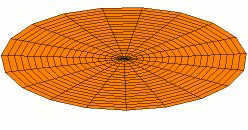|
Dunkerley's Method
Dunkerley's method is used in mechanical engineering to determine the critical speed of a shaft-rotor system. Other methods include the Rayleigh–Ritz method. Whirling of a shaft No shaft can ever be perfectly straight or perfectly balanced. When an element of mass is offset from the axis of rotation, centrifugal force will tend to pull the mass outward. The elastic properties of the shaft will act to restore the “straightness”. If the frequency of rotation is equal to one of the resonant frequencies of the shaft, ''whirling'' will occur. In order to save the machine from failure, operation at such whirling speeds must be avoided. Whirling is a complex phenomenon that can include harmonics but we are only going to consider ''synchronous whirl'', where the frequency of whirling is the same as the rotational speed. Dunkerley’s formula (approximation) The whirling frequency of a symmetric cross section of a given length between two points is given by: : N = 94.251 ... [...More Info...] [...Related Items...] OR: [Wikipedia] [Google] [Baidu] |
Rayleigh–Ritz Method
The Rayleigh–Ritz method is a direct numerical method of approximating eigenvalues, originated in the context of solving physical boundary value problems and named after Lord Rayleigh and Walther Ritz. In this method, an infinite-dimensional linear operator is approximated by a finite-dimensional compression, on which we can use an eigenvalue algorithm. It is used in all applications that involve approximating eigenvalues and eigenvectors, often under different names. In quantum mechanics, where a system of particles is described using a Hamiltonian, the Ritz method uses trial wave functions to approximate the ground state eigenfunction with the lowest energy. In the finite element method context, mathematically the same algorithm is commonly called the Ritz-Galerkin method. The Rayleigh–Ritz method or Ritz method terminology is typical in mechanical and structural engineering to approximate the eigenmodes and resonant frequencies of a structure. Naming and attribution ... [...More Info...] [...Related Items...] OR: [Wikipedia] [Google] [Baidu] |
Second Moment Of Area
The second moment of area, or second area moment, or quadratic moment of area and also known as the area moment of inertia, is a geometrical property of an area which reflects how its points are distributed with regard to an arbitrary axis. The second moment of area is typically denoted with either an I (for an axis that lies in the plane of the area) or with a J (for an axis perpendicular to the plane). In both cases, it is calculated with a multiple integral over the object in question. Its dimension is L (length) to the fourth power. Its unit of dimension, when working with the International System of Units, is meters to the fourth power, m4, or inches to the fourth power, in4, when working in the Imperial System of Units or the US customary system. In structural engineering, the second moment of area of a beam is an important property used in the calculation of the beam's deflection and the calculation of stress caused by a moment applied to the beam. In order to ... [...More Info...] [...Related Items...] OR: [Wikipedia] [Google] [Baidu] |
Vibration
Vibration () is a mechanical phenomenon whereby oscillations occur about an equilibrium point. Vibration may be deterministic if the oscillations can be characterised precisely (e.g. the periodic motion of a pendulum), or random if the oscillations can only be analysed statistically (e.g. the movement of a tire on a gravel road). Vibration can be desirable: for example, the motion of a tuning fork, the reed in a woodwind instrument or harmonica, a mobile phone, or the cone of a loudspeaker. In many cases, however, vibration is undesirable, wasting energy and creating unwanted sound. For example, the vibrational motions of engines, electric motor An electric motor is a machine that converts electrical energy into mechanical energy. Most electric motors operate through the interaction between the motor's magnetic field and electric current in a electromagnetic coil, wire winding to gene ...s, or any Machine, mechanical device in operation are typically unwanted. ... [...More Info...] [...Related Items...] OR: [Wikipedia] [Google] [Baidu] |
Mechanical Resonance
Mechanical resonance is the tendency of a mechanical system to respond at greater amplitude when the frequency of its oscillations matches the system's natural frequency of vibration (its '' resonance frequency'' or ''resonant frequency'') closer than it does other frequencies. It may cause violent swaying motions and potentially catastrophic failure in improperly constructed structures including bridges, buildings and airplanes. This is a phenomenon known as resonance disaster. Avoiding resonance disasters is a major concern in every building, tower and bridge construction project. The Taipei 101 building for instance relies on a 660-ton pendulum—a tuned mass damper—to modify the response at resonance. The structure is also designed to resonate at a frequency which does not typically occur. Buildings in seismic zones are often constructed to take into account the oscillating frequencies of expected ground motion. Engineers designing objects that have engines must ensure t ... [...More Info...] [...Related Items...] OR: [Wikipedia] [Google] [Baidu] |

